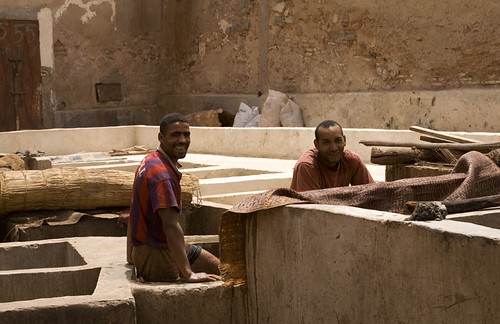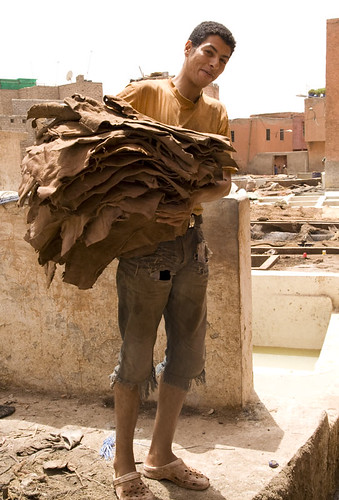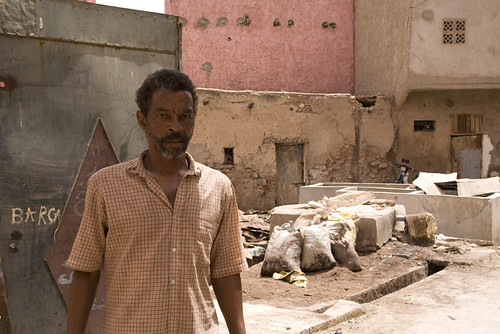
The next day James and I set off on a quest to find the tanneries. We read about it in the guide and it was described as a foul smelling place, but interesting none the less. So we leave in the morning and the girls go shopping. As we get near the tannery area and away from the main square people on the streets start to try to guide us. All the locals seem to know that if any foreigners are in that area they are looking for the tanneries. We know that this is ploy to try to get money out of us so we continue walking and ignore them.
The entire time we are walking the locals try to get our attention to go into their shops. James is a tall white guy with long dreads so he is hard to miss. So our journey to the tanneries, is filled with shouts of Rasta! Rasta Man! Bob Marley! And for me, I get Bruce Lee! Jakie Chan! Arigatou! Konnichiwa! I don't mind being called Bruce Lee all the time, Bruce Lee is badass. And even Jackie Chan is okay in my book. On the rare occasion it got real annoying when I would hear chin chong! in which I respond with derka derka (I don't think they got it). While I was busy attempting to cause an international incident, we both smell an odor of rotting flesh.

We finally reach the tanneries and are guided inside by one of the workers. He gives us a handful of mint leaves to use to help adjust to the decaying flesh smell of the leather curing process. The text in the guidebooks did nothing to prepare us for the foul odor that hit as like a brick wall. It took me a second to stomach the smell, I had to take several whiffs of the mint leaves to even continue walking in. I can’t even begin to describe the smell to do it justice, so I’ll just leave it at that.

The leathers come to the tanneries with fresh flesh and hairs still attached. So the first step is to remove the flesh and hairs. This is done either by soaking the skins in urine, soaking them in limestone water mixtures or leaving them out over the period of several months. This particular tannery used all three methods depending on the type of skin.
The next step is to put the soak the skins in pigeon poop. Men usually step on these skins to help apply the dung to the skins. This process lasts between several hours to days. The worker tells us that the pigeon poop solution can be substituted with animal brains, but pigeon poop is better. During this process the skins are also soaked in poops of lard, limestone-water mixture. The pools are made out of limestone and have been around since the start of the tanneries. This process is passed down from generation to generation.

Speaking of pigeons, one of the things I’ve noticed about Marrakech is irregular lack of pigeons. I soon found out that pigeons are considered a delicacy, so they are all caught and eaten. Pigeon actually costs more than rabbit here. Anyways back the leather soaked in the lard solutions. After curing for a week or so the skins are moved to the roof where they are dried. Once dried they are made soft using various minerals and again pigeon poop. After drying they are finally ready for the leather smith to be made into various goods.

Our tour goes right through the rancid smelling pits. The guide tells us to watch our step as some of the pits are covered and it is easy to accidentally fall into the pits of foul waters. I ask the guide and he confirms that he has fallen in numerous times. We continue to two tanneries one is Arabic and the other is Berber. I couldn’t really understand what made one tannery different from the other. They both smelled and made me noxious. The final part of the tour ended at a leather smith shop where a sales guy tried to sell us leather bags to seats. We didn’t bite and politely exited. As we were departing the main guy that was giving us the tour demanded 200 dirhams from each of us for the tour. We bargained and bargained and settled for 50 each, which was still a huge rip off on our part.
No comments:
Post a Comment